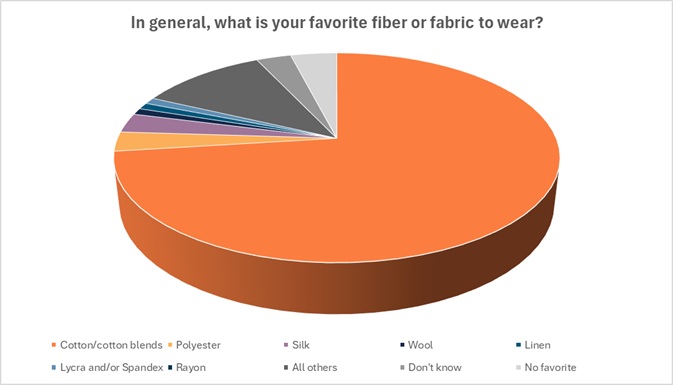The New York Fashion Week and New York Men’s Day events wrapped last week, and it was clear from both runway shows and presentations that natural fibers like cotton will be playing an important role for Spring/Summer 2026.
“Most of those vintage pieces were made of 100 percent natural fibers like cotton and wool….They last forever and that’s why they last forever. They’re well made, and they’re made with 100 percent cotton. So, our mindset is, how do we create something that people are going to want to wear forever and that will last forever? And cotton is the obvious answer to that.”
Jack Milkes, co-founder, Peak Lapel
“Cotton is the material I wear the most, and that’s kind of year round,” said Peak Lapel’s Jack Milkes, co-founder of the brand with Ben Stedman, in an interview with the Lifestyle Monitor™ at New York Men’s Day (NYMD). Peak Lapel is a unisex brand made in New York. “In the summer, cotton is the material I’m most comfortable wearing. So, I want to put that feeling into the clothing. We have a lot of tideship (nautically themed) cotton, and we’re bringing out the characteristics of 100 percent cotton, showing how it can stretch, mold and be cut on the bias. There are so many ways you can work with it, so you don’t have to use synthetics, which hurt the environment.”
Peak Lapel offered American prep-style pants, shirts, and crisp blazers in a cotton-rich collection entitled “Lawn Games,” inspired by a student’s time in-between semesters: the summer season. “I don’t think there’s a piece that doesn’t have cotton in it,” Milkes said. “It’s our go-to.”
Meanwhile, the Norma Kamali show featured a new take on her iconic sweats pieces. Her “Spring Sweats” fabric is a cotton-blend, brushed terry. The designer promotes it as being as soft as cashmere, but with no shrinkage. Spring’s color is a light heather gray – and Kamali’s spring collection features the fabric in an oversized shawl cardigan, bottoms, skirts, shorts, and dress pieces.
Designers and brands that lean into natural fibers like cotton are likely to connect with today’s shoppers. Consider that nearly three-quarters of consumers (73 percent) say cotton or a cotton blend is their favorite fabric to wear, according to the 2025 Cotton Incorporated Lifestyle Monitor™ Survey, in a survey of 4,000 consumers. All other fabrics significantly trail cotton in popularity, including polyester and silk (each 3 percent), wool, linen and Lycra (each 1 percent), and rayon (less than 1 percent).

Nearly 8 out of 10 consumers (78 percent) say they think better quality garments are made from all-natural fibers such as cotton, according to the Monitor™ research. And a point that makers and retailers should keep in mind when choosing fabrics for their collections: the majority of consumers (59 percent) say they are willing to pay more for clothing made of natural fibers like cotton.
Clara Son also showed her eponymous collection at NYMD. She titled her spring collection “Reset,” giving it a story that takes place in the bedroom – where one would go when dealing with a challenging time.
“I was going with the idea of repetition, but also the idea of collapsing beautifully,” Son told the Lifestyle Monitor™ in an interview at the NYMD show. “You’ll see a lot of repetitive details like stripes, ruffles, pleats and more. And we’re also heavily influenced by the Victorian era in men’s nightwear, so you’re going to see bonnets, beads and tassels.”
Son’s collection featured tones of cream and brown, along with deep blue, acid green, grays, and white. Cotton and cotton blends are used throughout the collection.
“I try to source sustainable fibers as much as possible,” Son said. “We do care about that. Becoming 100 percent sustainable is really challenging, but we’re trying to do as much as we can.”
More than half of all U.S. consumers (57 percent) say sustainability/environmental friendliness influences their clothing purchase, according to Cotton Incorporated’s 2023 Global Sustainability Survey (n=1,013). And nearly half of all shoppers (47 percent) have paid more than they were planning in order to purchase a clothing item that was environmentally friendly or sustainable.
Outside of sustainability factors, most consumers generally feel cotton is best suited for today’s fashion (58 percent), according to the Monitor™research. More than half of all consumers (58 percent) say if clothes have more cotton in them than other fibers, they’re more comfortable, followed by softer (51 percent), better quality (46 percent), more natural (38 percent), and last longer (31 percent).
Mark Smith Clarke, the designer behind the genderless Archie collection, discussed his use of natural fibers in an interview with the Lifestyle Monitor™at NYMD. He highlighted the versatility of cotton, noting its ability to be both matte and crisp, making it a versatile starting point for his collections.
“When it’s milled really well, cotton is maybe the most versatile material,” Smith Clarke told the Lifestyle Monitor™. His Spring ’26 collection features a crinkled cotton blend that is used for trench and blouson jackets, as well as shorts.
Cotton turned up in a multitude of runway shows throughout New York Fashion Week. Consider Private Policy’s woven shirts, denim jeans, cargo pants, raw-edge cargo shorts, and drapey bottoms. The fabric was used dramatically in the Aknvas runway show, turning up in denim shirts with oversized stitching, architectural trenches and deep-pocketed khakis. Collina Strada employed cotton in various pieces, including voluminous denim bottoms, woven shirts, and baby tees.
Back at the NY Men’s Day show, Peak Lapel’s Milkes said the Spring ’26 collection was influenced by vintage garments,
“Most of those vintage pieces were made of 100 percent natural fibers like cotton and wool,” Milkes said. “They last forever and that’s why they last forever. They’re well made, and they’re made with 100 percent cotton. So, our mindset is, how do we create something that people are going to want to wear forever and that will last forever? And cotton is the obvious answer to that.”
